2024 Architectural Heritage Awards winners raise the bar in heritage conservation
Sign up now: Get ST's newsletters delivered to your inbox
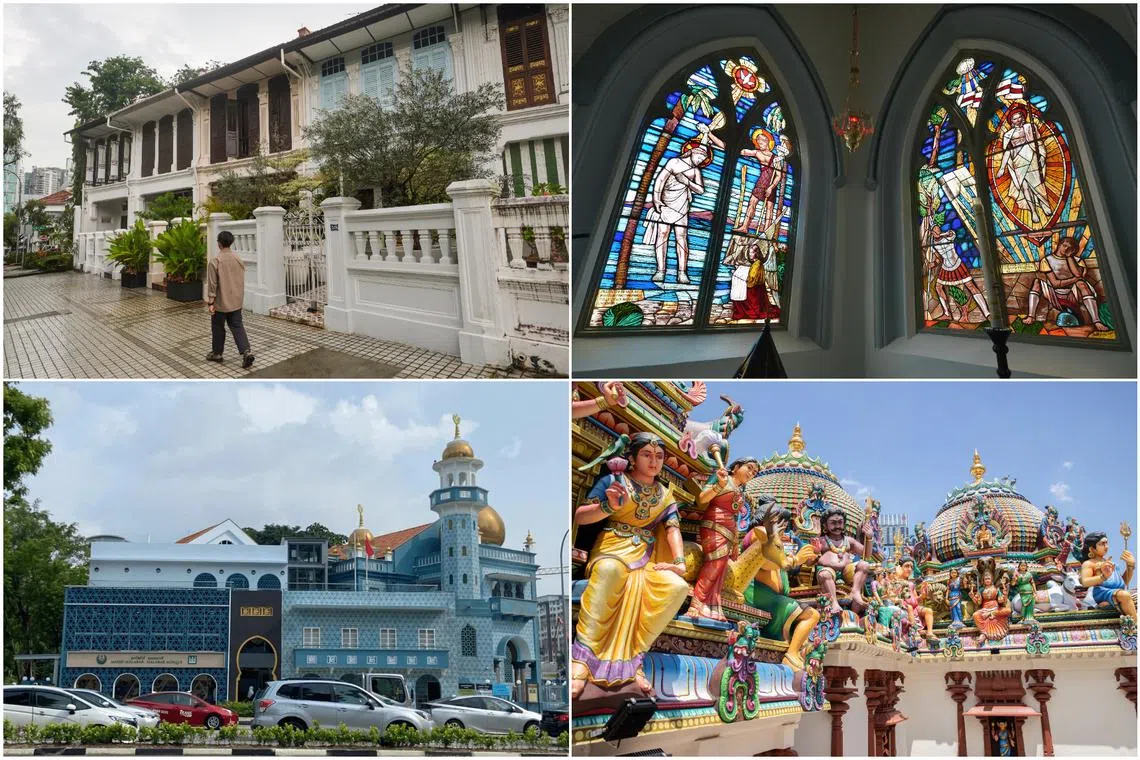
(Clockwise from top left) 59 Emerald Hill Road, St Joseph’s Church (Victoria Street), Sri Mariamman Temple and Malabar Mosque.
PHOTOS: GIN TAY, KUA CHEE SIONG, HINDU ENDOWMENTS BOARD, LIU & WO ARCHITECTS
Follow topic:
SINGAPORE – A Catholic church with statues and stained glass brought back to life, a Hindu temple restored with the help of drone footage and a Malabari mosque expansion are some of the highlights of the biennial 2024 Architectural Heritage Awards (AHA) by the Urban Redevelopment Authority (URA).
The work done at these places of worship, as well as other projects such as an Emerald Hill townhouse, have raised the bar on heritage conservation in Singapore.
Minister for National Development and Minister-in-charge of Social Services Integration, Mr Desmond Lee, who handed out the five Awards for Conservation and four Special Mentions at a ceremony on Nov 8, lauded the high standards the teams committed to.
He praised the team behind residential townhouse 59 Emerald Hill Road for its exhaustive efforts.
“We don’t often see this level of care and attention given to the restoration of a residential interior,” Mr Lee said, referring to the historic building near Orchard Road.
“I would like to commend the owner, Ms Dawn Chan, for her enlightened approach of sensitive restoration and minimal intervention to beautifully highlight the house’s innate architectural charm while meeting present-day needs. We hope that she will inspire other home owners to take equal pride in their heritage properties.”
While some of the bigger projects such as the Bukit Timah Railway Station (Award for Conservation with Distinction) and Bukit Timah Truss Bridges (Award for Conservation) were ground-breaking, smaller projects such as Sri Mariamman Temple, St Joseph’s Church (Victoria Street) and Malabar Mosque employed complex approaches to conservation.
The AHA was established in 1995 to recognise well-restored monuments and conserved buildings in Singapore, and the people behind them.
Professor Ho Puay Peng, who holds the Unesco Chair on Architectural Heritage Conservation and Management in Asia, at the Department of Architecture, College of Design and Engineering, National University of Singapore, says conservation practices have evolved with changing emphasis and focus since the awards began.
He was part of the 2024 AHA assessment committee comprising 11 judges, who also included Mr Peter Ho, chairman of URA, and Mr Yeo Kirk Siang, group director (policy and community) at the National Heritage Board.
“The criteria is no longer the same,” Prof Ho says, pointing out that projects have to push the boundary in areas such as community involvement, technical advancement and sustainable development.
Prof Ho, who has served as a judge in numerous conservation awards in Singapore and Asia, says the standard in Singapore has progressed to be on a par with Asian standards.
“This is particularly true in the area of community involvement, engagement and empowerment. Conservation is about managing change for the community and AHA has served its objectives by encouraging good practices including community participation.”
The Straits Times scopes out four extensive conservation efforts.
A 1920s townhouse frozen in time
59 Emerald Hill Road (Award for Conservation)

The facade of 59 Emerald Hill Road.
PHOTO: GIN TAY
The white-and-blue facade with the hallmark pintu pagar (Malay for “swing doors”) of the two-storey townhouse at 59 Emerald Hill Road stands out from the other 16 colourful units in the row in the conservation enclave near Orchard Road.
The properties were developed in the early 1920s by Mr Low Koon Yee, a wealthy Teochew merchant. The townhouse, which won an Award for Conservation, remained within the Low family for three generations until it was put on the market several years ago.
Designed in 1924 by South Indian architect and surveyor Rethinam Thamby Rajoo Pillay, also called R.T. Rajoo, it is a rare example of a mostly intact townhouse, with architectural features that shed light on the tastes of wealthy local Asian families who moved into the enclave during the interwar years between 1918 and 1939.
Characterised by a blend of European and Straits Chinese architectural styles, the townhouse stands out for its well-preserved internal and external historic elements.
With a focus on minimal intervention, the project serves as a model for other owners on how to be good custodians of their historic homes.

The timber lattice panel on the second floor.
ST PHOTO: GIN TAY
The conservation also revealed a long-hidden timber lattice on the second floor, one of only a few known to exist in Singapore.
The jury citation pointed out that “extraordinary effort has also been noted in the sourcing of authentic vintage materials which complement the existing period fittings and cabinetry”.
“With a colour scheme thoughtfully chosen after meticulous paint stripping and colour matching to harken back to its original 1924 look, this house is poised to enhance the distinctive character of Emerald Hill,” the judges wrote.
In 1989, Emerald Hill became a conservation area when URA formalised its Conservation Programme. The area was chosen to preserve some of the best extant examples of pre-World War II traditional terrace dwellings on the island.
The conservation of No. 59 was headed by Mr Ho Weng Hin, architectural conservator and co-founder of Studio Lapis, who worked with a team comprising engineering firm Keon Consult, contractor HB Resources, timber restorer Foo Woodmaking, tile specialist Laim-Tec and French interior designer Frederic Blachier, who runs his eponymous firm in Paris.
Mr Ho says owner Dawn Chan engaged his architectural conservation consultancy in 2022, shortly after she bought the unit, with the intention to carefully recover, restore and celebrate the architectural character of the townhouse.
Ms Chan, who was born in Singapore, is currently based in London and pursuing a master’s at the Courtauld Institute of Art.
“After the owner engaged us, we started photographic documentation of the site to visually identify the historical elements and their state of deterioration,” says Mr Ho, who was also the expert for the restoration of Jiak Kim House in Jiak Kim Street, which also won an Award for Conservation in 2024.
The visual documenting allows for systematic recording of the building condition to develop the eventual scope of works.

The cast-iron balustrade on the staircase.
ST PHOTO: GIN TAY
The Studio Lapis team also conducted historical research on both the townhouse and the context of the site to get a better understanding of the building and history of the location.
A thorough precondition survey assessed the building to be structurally sound. However, signs of wear and tear after a century of use were evident. The systemic research and documentation guided the scope of the restoration works.
The curved “pantile” or fired clay roof tiles were removed and replaced with traditional V-shaped tiles, reinstating the roof’s original design, says Mr Ho.
He also noted that the townhouse has some key differences from those built in the preceding decades, such as those in Neil Road in the Blair Plain conservation area.
For instance, the Emerald Hill building does not have any internal light wells, unlike those in Neil Road.
Instead, it has more pronounced tropical design features such as generous triple-bay French windows on the second floor, as well as a “modern” sanitary block and a rear court that opens into the back lane, which did not exist in earlier townhouses in Singapore.
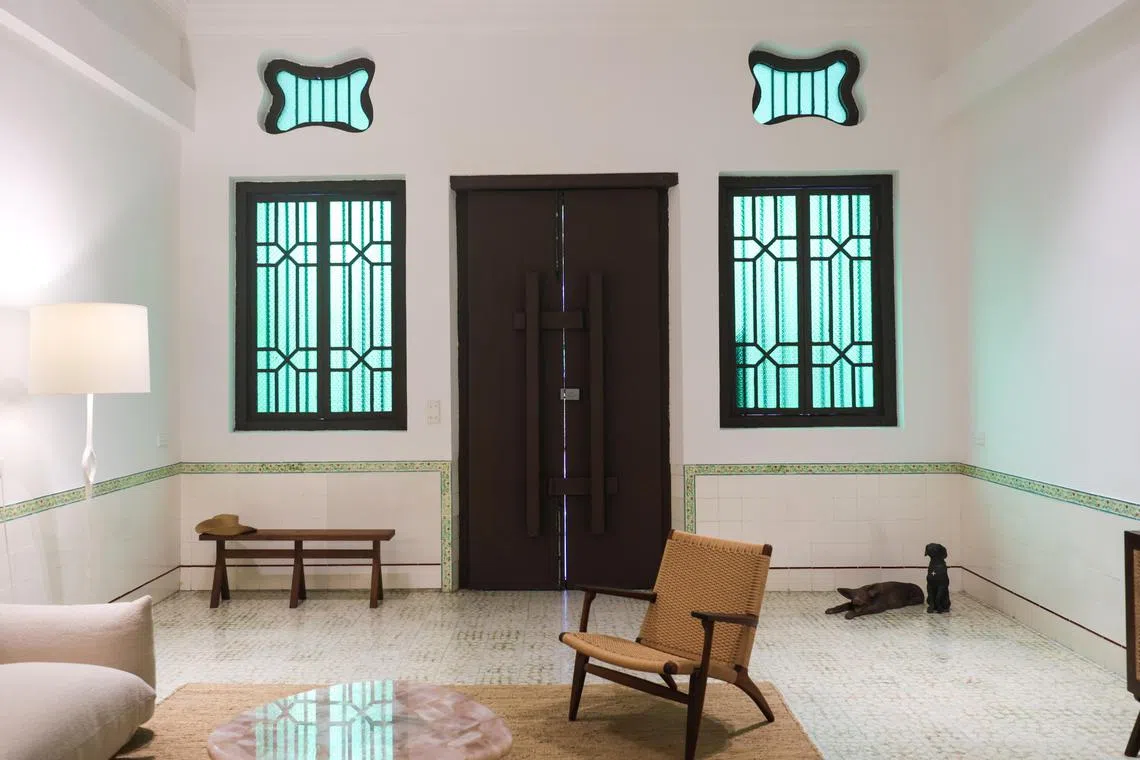
The living hall of 59 Emerald Hill Road.
ST PHOTO: GIN TAY
The team also noted that the artificial marble floor tiles in the front hall are still intact albeit stained by a century of use.
“Artificial marble tiles are versatile and attractive finishes, in vogue during the 1920s to 1930s, and they cost a fraction of the price of natural marble. But they were certainly an upgrade from the ubiquitous terracotta tiles used then,” Mr Ho says.
Artificial marble tiles relied heavily on skilled local craftsmen who replicated “marble veins” using pigmented cement powder.

Majolica tiles with peacock motif.
ST PHOTO: GIN TAY
Experts from Foo Woodmaking carefully removed the timber panels in the home for off-site restoration. They also removed thick layers of paint on windows and doors accumulated after almost a century of use to restore the functionality of the louvred panels.
Tile experts from home-grown Laim-Tec used the steam cleaning method, which is gentler compared with water jets. Dislodged tiles were reattached with lime mortar and careful colour-matching techniques were used to conserve the artificial marble tiles.
Ms Chan was amazed to find a house that still had most of the period features intact. When the project was completed, it was less of a “big reveal”, she notes, and more of a preservation of what was already there.
“When we travel, we visit palaces and museums that still have period details,” Ms Chan tells The Straits Times by phone from London. “They look, feel and smell different from contemporary buildings, and that’s the magic that I wanted to preserve through the conservation process at 59 Emerald Hill Road.”
Peeling back layers of history
St Joseph’s Church, Victoria Street (Award for Conservation)
What started out as a project addressing structurally unsound roof trusses, repairing a choir loft and removing crusted facade paint in 2017 burgeoned into a $25 million, five-year conservation of the 112-year-old St Joseph’s Church in Victoria Street.
When workers removing paint from the facade uncovered ornamental plasterwork dating to the early 1900s, the plan changed from mere renovation to conservation to return the church to its former glory.
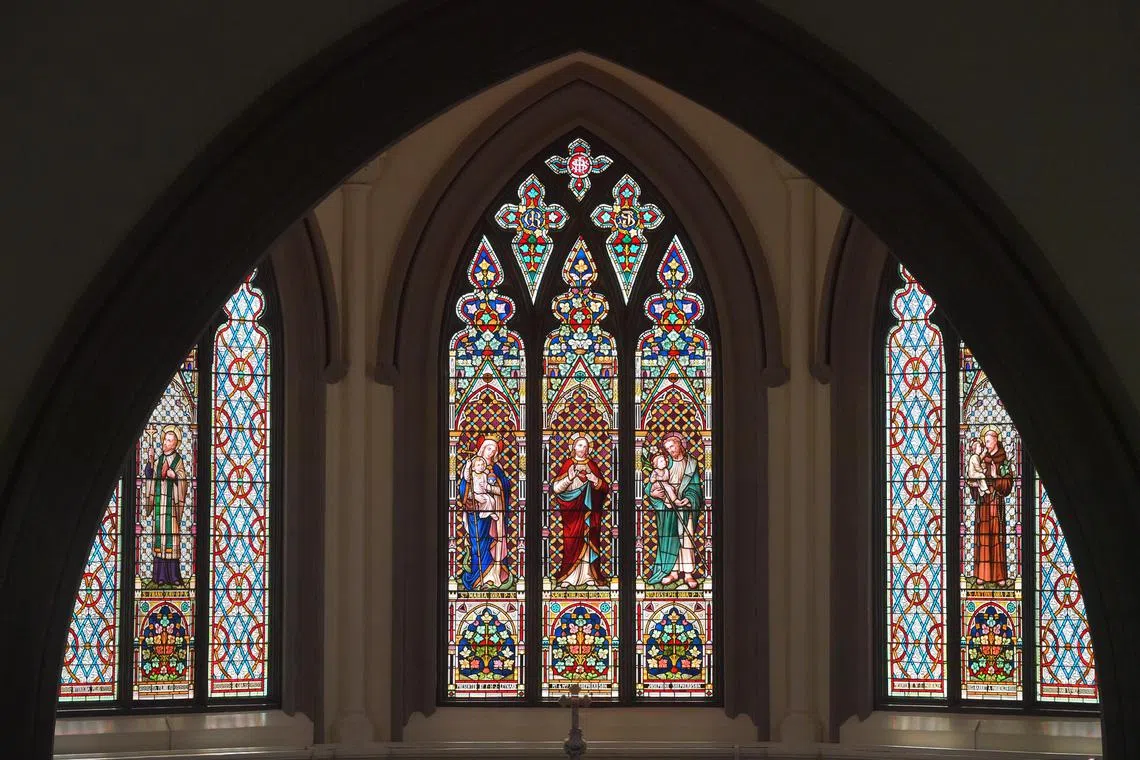
A team of eight stained-glass specialists worked on 72 windows with 604 individual panels for almost two years.
ST PHOTO: ALPHONSUS CHERN
The church was originally built by the Portuguese Mission in 1853 to serve Portuguese and Eurasian Catholics residing in Singapore. When the congregation grew, it was demolished.
On the same site, the present-day St Joseph’s Church was built in 1912. In 2005, the church was gazetted a National Monument by the National Heritage Board.
The team was helmed by Singapore-based Ong&Ong architects, who collaborated with engineering, fire safety, acoustic and lighting specialists, while conservation specialist FranzWood Associates brought in artisanal experts such as Genesis Stained Glass. Experts such as artefact specialist Filipa Machado were also called in.
“The restoration required specialists in a range of conservation disciplines such as restoring artefacts, marble and stained glass,” says Mr Joe Fu, director of Ong&Ong.
“Each specialist played an important role in bringing the church back to its former glory. The key in synergising the specialists is to ascertain the timeline and logistics. FranzWood played a big role in the management of the specialists.”
The team came up with sensitive solutions such as integrating ventilators in dormer windows, which were carefully reinstated based on evidence from the early 1900s. There was also discreet installation of new mechanical and engineering (M&E) systems within the existing architraves and cornices to achieve a seamless integration of contemporary equipment within the historic fabric of the old church.
The team paid special attention to details in the mapping, cleaning, repair and replacement of historic materials such as the original encaustic tiles, a form of inlaid cement tiles with distinct patterns.
Artisans worked delicately on the restoration of key features of the church.
For instance, Ms Machado, who founded Red Dot Restoration in Singapore in 2020, was in charge of restoring all the artefacts in St Joseph’s Church. This included the restoration of 34 full-sized statues, 14 Stations of the Cross and a decorative mural painting on the staircase leading to the choir loft.
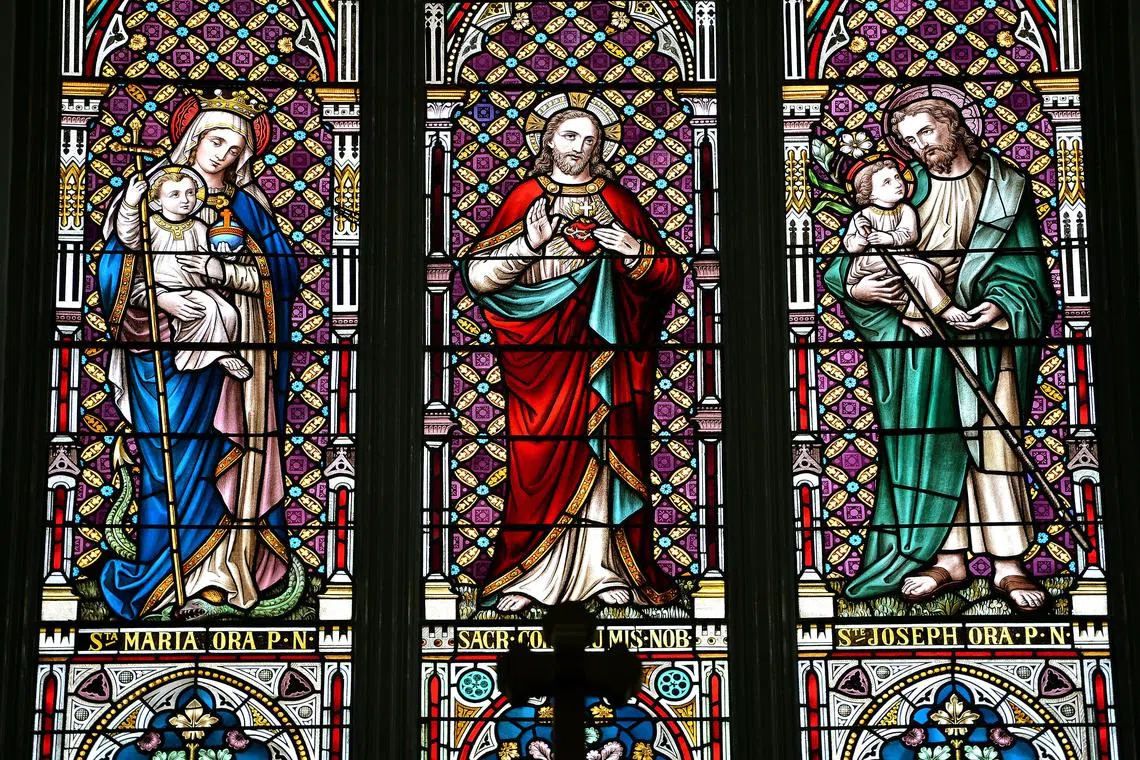
The cracked green heart of Jesus was replaced with a new red sacred heart in the centre panel at the newly-restored St. Joseph's Church in Victoria Street.
ST PHOTO: KUA CHEE SIONG
Ms Machado notes that over the years, these sculptures and artefacts had been overpainted.
“During the conservation of the statues, it was thrilling to discover that the original paint layer, once the overpaint was removed, was in excellent condition. Almost all the statues revealed stunning and intricate gold leaf patterns that had been hidden for years,” says Ms Machado, who moved to Singapore with her family from Portugal in 2015.
Ms Irene Lim, who heads one of Singapore’s top glass art studios, Genesis Stained Glass, says the restoration of St Joseph’s Church’s windows was an intricate project.
It involved a detailed process starting from documenting and preserving the historical integrity of the glass, sourcing for materials from as far away as the United States to matching the original panels and carefully dismantling the pieces to restore vibrancy to the glass.
A team of eight stained-glass specialists worked on 72 windows with 604 individual panels for almost two years.
Says Ms Lim: “Throughout the restoration, we adhered to strict conservation guidelines, ensuring that the design, colours and craftsmanship were preserved while bringing new life to the artwork.
“Our team also worked closely with church representatives and heritage experts to ensure that every detail met the high standards expected for such a culturally significant site.”
High-tech restoration for Singapore’s oldest Hindu temple
Sri Mariamman Temple (Special Mention)
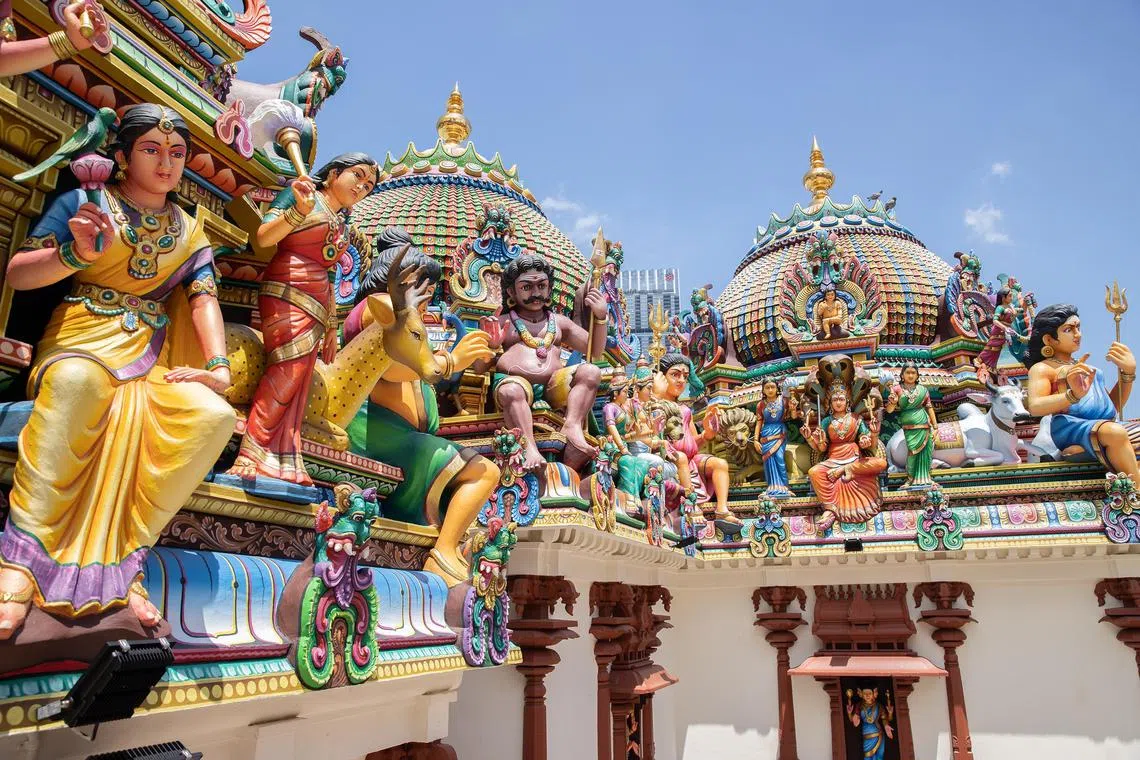
High-tech techniques such as photogrammetry of the sculptural figurines throughout Sri Mariamman Temple were conserved to retain their original colour and form.
PHOTO: HINDU ENDOWMENTS BOARD
When the newly unveiled restoration of Sri Mariamman Temple took place on Feb 12, 2023 as part of the temple’s grand consecration, more than 20,000 devotees turned up for the early morning event in South Bridge Road, with some queuing since dawn.
The year-long, $3.5 million restoration by a team comprising Caide Architects and local conservation specialist Maek Consulting, in collaboration with the temple’s administrator, the Hindu Endowments Board (HEB), started in 2021 and included high-tech techniques using drone technology.
The jury citation called it a “true labour of love”, combining scientific investigation with traditional craftsmanship.
Sri Mariamman Temple was designed according to ancient South Indian temple architecture, which features an imposing tower or gopuram with ornate and colourful figurines depicting mythological characters and deities.
Established in 1827, it is Singapore’s oldest Hindu temple dedicated to the worship of Goddess Mariamman – believed to be an incarnation of the Hindu mother of creation.
The big reveal of the conservation was scheduled to coincide with the grand consecration ceremony, Maha Kumbhabishegam, in February 2023. According to Hindu tenets, temples must be consecrated once every 12 years to re-energise the structure as well as improve key aspects of the design prone to deterioration.
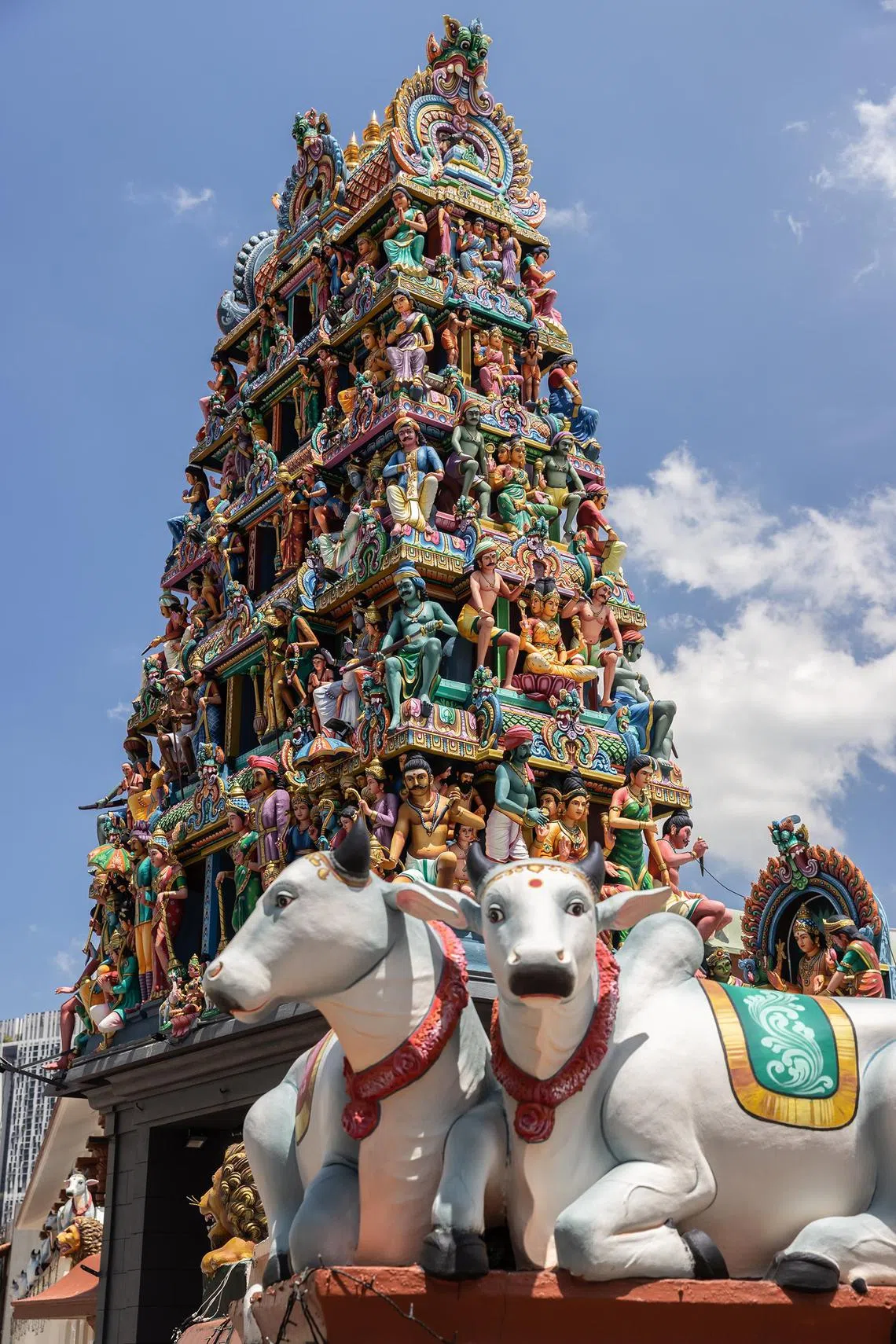
Sri Mariamman Temple was designed according to ancient South Indian temple architecture.
PHOTO: HINDU ENDOWMENTS BOARD
Apart from the gopuram, there are also other domes inside, called vimanams, which house different deities of the Hindu pantheon.
To adhere strictly to ancient Hindu scriptures governing temple design, HEB consulted with a traditional temple architect or “sthapati” from Chennai, Dr Dakshinamoorthy Sthapati. He flew here with 12 Indian temple artisans in 2022.
He found that the temple had gone through several major redevelopments since around 1862, when the initial wooden structure later became a concrete building.
Some early parts were constructed using granite stones and bricks, while later sections used reinforced concrete. For instance, the gopuram and vimanams belong to different eras and were constructed using a range of materials.
The restoration required an in-depth study of the materials used and the works carried out over time, and using the appropriate restoration methods.
As one of the Hindu temples here with the most number of religious events held throughout the year, wear and tear had been extensive. Dr Dakshinamoorthy noted that dust and pigeon droppings had also taken a toll.
“Sri Mariamman Temple has unique features, representative of Singapore’s multicultural background,” says Dr Dakshinamoorthy, an architect and sculptor.
“Examples of these are the trefoil arches in the temple hall and circular windows at the entrance, which are rare in Indian temple design. We had to ensure that these unique features are carefully preserved. As a monument to Hindu temple architecture in Singapore, it was also necessary to ensure the paintings, frescoes and sculptural figurines retained their original colour and form.
“But the main concern at the time was to complete the restoration and address all the challenges of the site within about 12 months before the consecration ceremony.”
That was where Mr Wong Chung Wan, director of Maek Consulting, and his team came into the picture.
They collaborated with HEB and the temple’s management to create a roadmap for the restoration.
His team provided technical support for a detailed diagnostic investigation of the condition of the paintworks in the gopuram and vimanams, and the cause of the paint deterioration. This involved extracting fragments of the paint layers for microscopic examination.
The paint samples revealed that a unique orange layer was found consistently throughout the temple. This layer was later identified as minium, a lead-based pigment that has been reported to be one of the pigments used in the construction of Angkor Wat, the 12th-century temple complex in Cambodia.
The team then removed the deteriorated paintwork and treated the surfaces to absorb new paint, as well as developed an on-site protocol to inspect and assure the quality of the works at different stages of the process.
“To better acquaint ourselves with the temple, extensive background research was carried out, including the history of the paints used and the temple construction through archival search,” says Mr Wong.
The priority was the gopuram, due to crumbling paintwork, cracks and spalling of the plasterworks arising from corrosion. “To determine the extent of the damage, we used drone photography to create a 3D image through photogrammetry of every figurine in the gopuram,” says Mr Wong.
Photogrammetry is the science of extracting 3D information from photographs. The process involves taking multiple shots of a structure and converting them into a digital twin for more accurate inspection and analysis.
HEB and the temple committee are grateful that the efforts were recognised with a Special Mention.
“Everyone from Dr Dakshinamoorthy to Maek Consulting to the team of skilled sculptors and craftsmen we sourced from India, had worked meticulously to beautifully restore the temple,” says Mr T.G. Gritharan, the temple’s vice-chairman.
“Throughout the conservation, we continued to operate, offering religious services and holding festive celebrations albeit on a smaller scale. The devotees and volunteers witnessed the restoration progress every step of the way.”
Malabar Mosque expansion project strikes delicate balance
Malabar Mosque (Special Mention)
The Malabar Mosque is one of the mosques in Singapore which are mainly managed by the Malabar Muslim community here, whose forefathers came from Kerala, India.
Malabar Muslims are Malayalees, a South Indian ethnolinguistic group originating in the Malabar coast of Kerala, and who are one of the earliest groups to embrace Islam in India. Unlike the rest of the subcontinent where Islam took root gradually, the Malabar coast received Islam directly from Arabia through maritime trade routes.
The 60-year-old mosque, located at the intersection of Jalan Sultan and Victoria Street, was originally designed by North Indian immigrant A.H. Siddique and opened in 1963 by the then head of state Yusof Ishak.
The mosque underwent a renovation, completed in 1995, that saw the addition of precious blue and white lapis lazuli tiles to its distinctive facade.
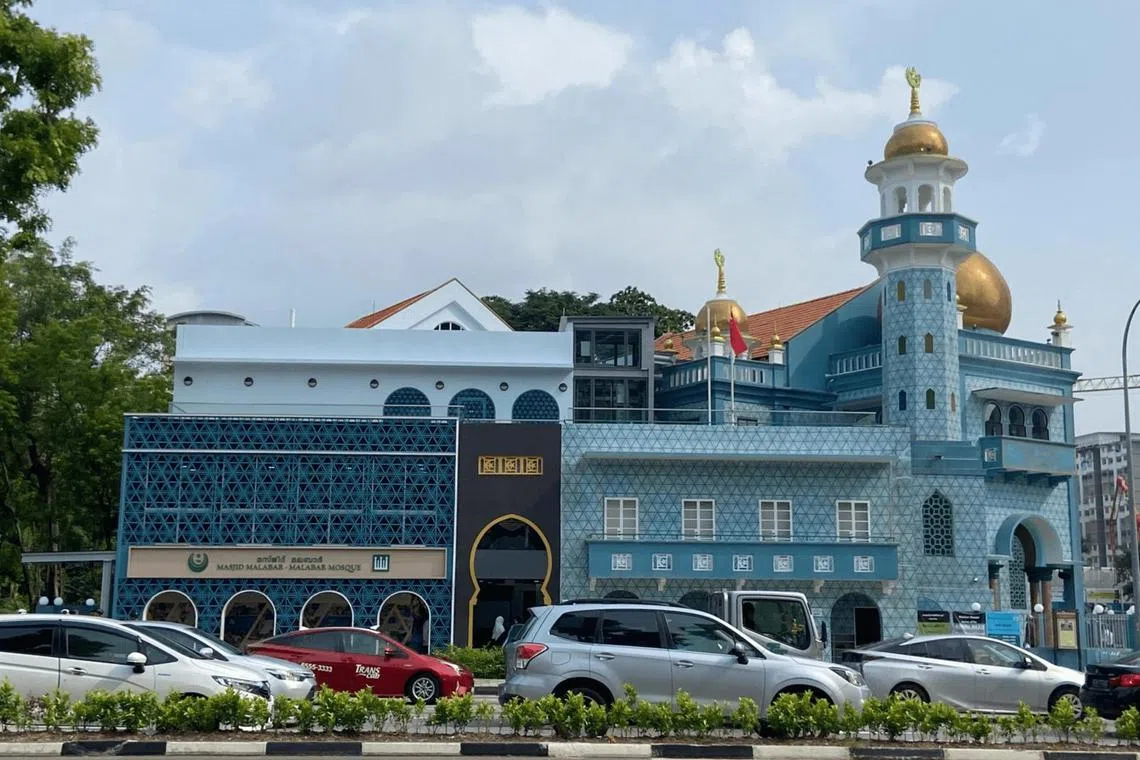
Malabar Mosque received a Special Mention at the Architectural Heritage Awards 2024.
PHOTO: LIU & WO ARCHITECTS
Its three-year conservation, which won a Special Mention, started in August 2020 and was helmed by a team from home-grown practice Liu & Wo Architects.
The refurbishment included expanding the site by 592 sq m by building a three-storey annexe, as well as restoring parts of the old mosque. This resulted in increased prayer spaces, additional classrooms and improved accessibility with lifts, ramps and stairs.
The mosque’s owners asked for an annexe to house a heritage gallery, as well as to provide more space for prayers and public programmes.
The firm also adopted a detailed conceptual approach guided by URA’s conservation guidelines, resulting in a design that respects the historical and cultural significance of the site.
The jury citation noted: “The project not only ensures the mosque’s continuity as a place of worship and gathering, but also inspires the Malabari Muslim community to become committed custodians, fostering a greater sense of pride and collective identity.”
Ms Wo Mei Lan, architect and co-founder of Liu & Wo Architects, led a team that also sought expert advice from Dr Imran Tajudeen, a senior lecturer at the Department of Architecture, College of Design and Engineering in the National University of Singapore.
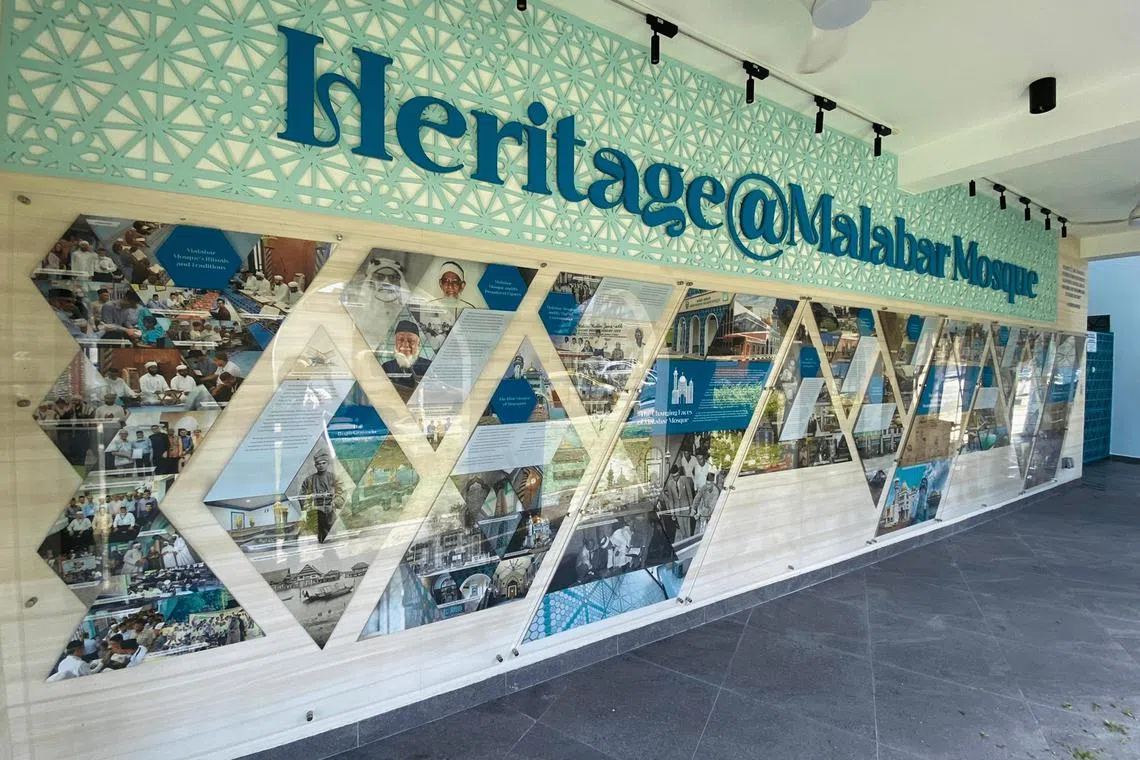
The Malabar Mosque is one of the mosques in Singapore which is mainly managed by the Malabar Muslim community here, whose forefathers came from Kerala, India.
PHOTO: LIU & WO ARCHITECTS
Dr Imran helped the team to understand the background and history of the Malabaris in Singapore, and guided the design approach, given the site’s history as an ancient burial ground and its significance to the community.
“We wanted to ensure a respectful and informed approach to the design,” says Ms Wo.
The former chairman of Malabar Mosque, Haji Osman Abdullah, praised the heritage gallery, saying it has received positive feedback from the community, as well as tourists.
“The gallery is a platform to showcase and preserve the traditions and history of Malabar Mosque and the Malabari community,” said Mr Osman, who is also an adviser to the mosque management committee.
Malabar Mosque’s senior executive chairman, Haji Muhammad Khairul Jameel Yahya, welcomed the Special Mention, citing it as recognition of the collective efforts of the community.
“This award represents the close collaboration, dedication and commitment of not just the Malabar Mosque community, but also the Islamic Religious Council of Singapore, its subsidiary company Warees Investment, stakeholders and professionals.”


